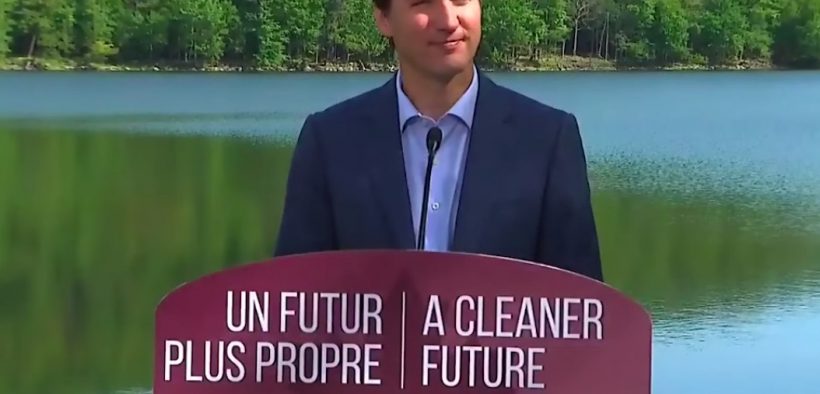Canada Announces Ambitious Plan to Curb Plastic Waste Pollution

Plastic can take more than 400 years to degrade and most of it litters our oceans and waterways.
In a statement released on Monday, Canadian Prime Minister Justin Trudeau announced that the country will prohibit the use of single-use plastic materials starting in 2021.
The prime minister did not mention the specific products to be banned. However, plastic-based materials such as straws, plastic bags, plates, stir sticks and cutlery would likely be prohibited if supported by scientific research.
Trudeau said that Canada recycles less than 10 percent of its disposable plastics and is on track to throw-away $11 billion worth of disposable plastic by 2030 unless the situation changes.
The Liberal Party politician added the federal government would cooperate with provincial administrations to introduce standards and targets for producers and plastic retailers, enabling them to be more responsible for their plastic waste.
The 47-year-old prime minister also backed the effort of Canada’s Environment Minister to create a nationwide blueprint for zero plastic waste.
“This will be a big step, but we know we can do this for 2021,” Trudeau said while visiting the Gault Nature Reserve outside Montreal.
“You’ve all heard the stories and seen the photos,” Trudeau said. “To be honest, as a dad it is tough trying to explain this to my kids. How do you explain dead whales washing up on beaches across the world, their stomachs jam packed with plastic bags?
“How do I tell them that against all odds, you will find plastic at the very deepest point in the Pacific Ocean?”
Plastic Pollution Facts
According to Trudeau’s statement:
- Every year, Canadians throw away over 3 million tonnes of plastic waste. This represents up to $8 billion per year in lost value and wastes valuable resources and energy.
- About one-third of the plastics used in Canada are for single-use or short-lived products and packaging. In fact, in Canada, up to 15 billion plastic bags are used every year and close to 57 million straws are used daily.
- Every year, 640,000 tons of abandoned, lost or discarded fishing gear enters our oceans. It can persist in the environment for up to 600 years.
- Every year, one million birds and over 100,000 sea mammals worldwide are injured or die when they mistake plastic for food or become entangled.
- Globally, one garbage truckload of plastic waste enters the ocean every minute, and that amount is increasing steadily.
- Over the last 25 years, nearly 800,000 volunteers have removed over 1.3 million kilograms of trash from across Canada’s shorelines through Ocean Wise and World Wildlife Fund’s Great Canadian Shoreline Cleanup program, supported by the Government of Canada. The most commonly littered items on our shorelines are single-use or short-lived products, many made of plastics.
Other Countries Have Already Banned the Use of Plastic
More than 60 countries have decided to reduce the use of single-use plastic by imposing bans or taxes, according to a report from the U.N. released last year.
India, which is the world’s second most populous country, announced a plan under Prime Minister Narendra Modi to eliminate all single-use plastic by 2022.
China, the world’s most populous nation, is moving to stop plastic pollution by stopping its practice of buying plastic waste worldwide.
Japan has announced that it would charge plastic bags at grocery stores and department stores as an effort to tackle marine pollution from plastic waste.
“The proportion of plastic bags among plastic waste is not big, but charging would be symbolic” of Japan’s efforts to reduce such waste, Japan’s Environment Minister Yoshiaki Harada told the Japan Times.
Developed Nations Ship Their Plastic Waste to Developing Countries
A study published by the World Economic Forum (WEF) found that 90 percent of plastic waste in the world’s oceans comes from only 10 rivers. Eight of them are in Asia: the Yangtze; Indus; Yellow; Hai He; Ganges; Pearl; Amur; Mekong; and two in Africa – the Nile and the Niger.
If nothing is done to stop marine pollution from plastic waste, the WEF predicted that the amount of plastic waste will surpass the fish population in the world’s oceans by 2050.
But, developing nations cannot be solely blamed for causing plastic waste pollution. One part of the problem is the regular practice of developed countries shipping their plastic waste abroad because of the low cost, and because such an activity helps them to fulfill their recycling target.
However, according to a BBC report, only a tiny fraction of the plastics ever get recycled. Often, developed countries mislabel their plastic and unrecyclable materials end up being burned illegally, dumped in landfills or waterways, creating risks to the environment and public health.
The BBC reported that Malaysia just sent five containers of plastic waste back to Spain after saying it was contaminated. Malaysia also says up to 3,000 tonnes of rubbish will soon be returned to the U.K., U.S., Japan, China, Canada, Australia, the Netherlands, Germany, Saudi Arabia, Singapore, Bangladesh, Norway and France.
When China announced in 2018 that it would no longer buy plastic waste that was not 99.5% pure, Malaysia, Vietnam, Thailand, Indonesia, Taiwan, South Korea, Turkey, India and Poland all took up the slack.
Developing countries’ relaxed laws on the environment make them an attractive place for Western nations’ dumping grounds. Environmental watchdog Greenpeace accused developed countries of exploiting developing countries’ regulations’ loopholes.
US Is World’s Biggest Plastic Waste Exporter
The European Union is the world’s largest plastic waste exporter, but the U.S. is the biggest exporter for any single country.
John Hocevar, Ocean Campaign Director at Greenpeace, said that the U.S. once exported 70 percent of its plastic waste to China. But after China banned the import of plastic trash, the U.S. is turning to Southeast Asian countries.
“Instead of taking responsibility for their own waste, U.S. companies are exploiting developing countries that lack the regulation to protect themselves,” Hocevar told The Guardian as Business Insider quoted.
Southeast Asian Nations Are No Longer Dumping Grounds
At the end of May, Malaysia’s Minister of Science, Technology, Environment and Climate Change, Yeo Bee Yun, announced that her country would return 3,300 tons of plastic waste to its countries of origin: the U.S., Australia, the U.K., Holland, Germany, France, Norway, Japan, China, Saudi Arabia, Bangladesh, Canada and others.
“We urge the developed countries to review their management of plastic waste and stop shipping the garbage out to the developing countries,” said the young minister as The Independent quoted.
The 36-year-old woman added that despite being a small country, Malaysia cannot be bullied by developed nations, calling exporting plastic waste to third-world nations “unfair and uncivilized.”
On the same day, the Philippines followed suit by returning garbage trucks exported by Canada. In early 2019, Manila sent back 6,500 tons of plastic waste that could not be recycled to South Korea.
In 2018, the National Geographic reported a statistic that shocked scientists and environmentalists worldwide: only nine percent of the world’s plastic trash has ever been recycled.
“We all knew there was a rapid and extreme increase in plastic production from 1950 until now, but actually quantifying the cumulative number for all plastic ever made was quite shocking,” said Jenna Jambeck, a University of Georgia environmental engineer who specializes in studying plastic waste in the oceans.
“This kind of increase would ‘break’ any system that was not prepared for it, and this is why we have seen leakage from global waste systems into the oceans,” she added.















